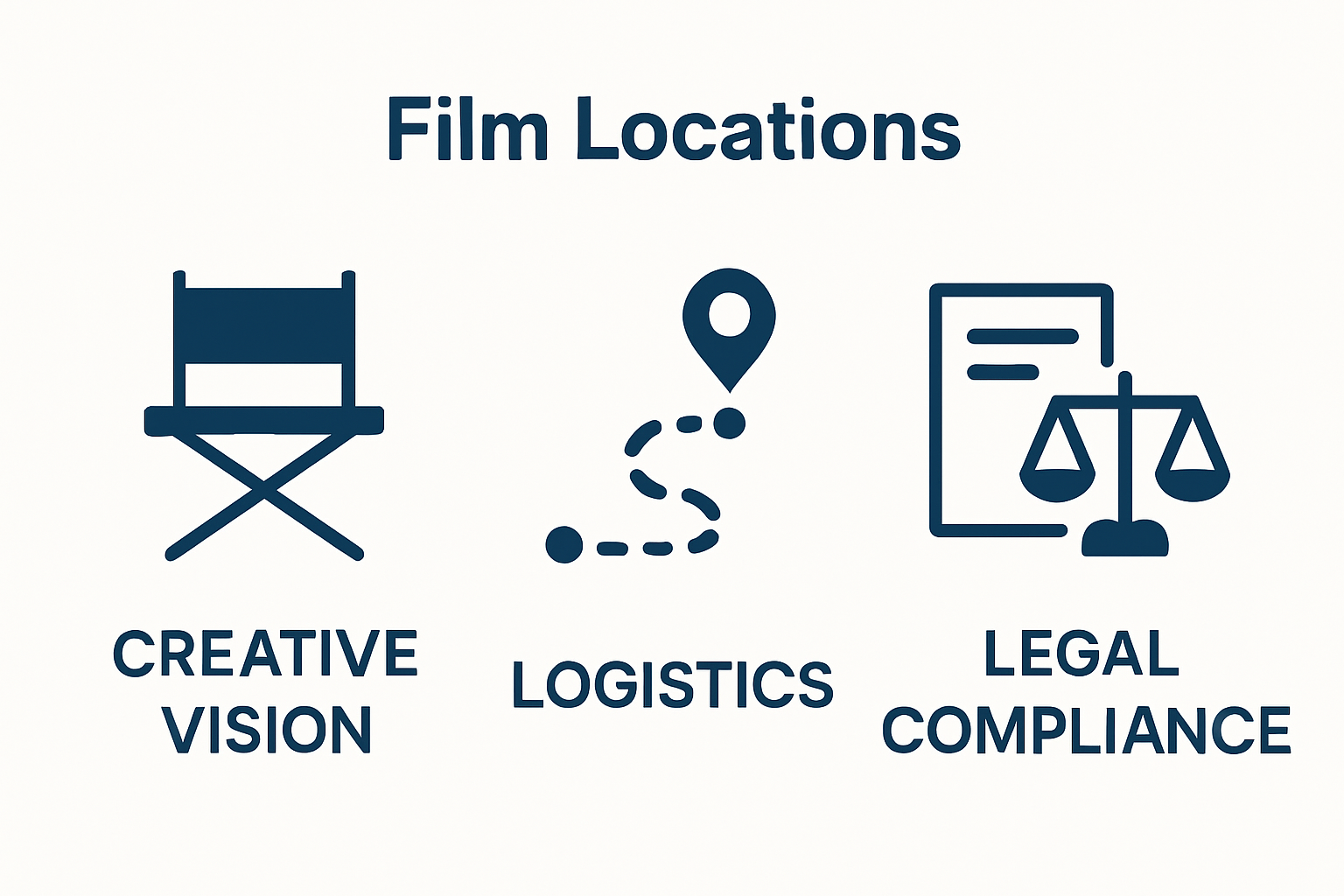Understanding Managing Multiple Locations for Filmmakers
- info1419758
- Aug 28
- 9 min read

Film production is rarely confined to a single set or city these days. Productions often span continents, and some major films have shot scenes in as many as 30 different locations across multiple countries. That sounds like a logistical nightmare, right? Actually, the biggest surprise is that the chaos behind the scenes can drive creativity even further, turning complicated logistics into unforgettable movie moments.
Table of Contents
Quick Summary
Takeaway | Explanation |
Effective location management enhances storytelling | Using multiple locations allows filmmakers to create diverse visuals, enriching narratives and emotional depth. |
Proper planning mitigates logistical challenges | Successful multi-location management demands detailed planning to synchronize schedules, transport, and resource allocation effectively. |
Understanding local regulations is crucial | Ensuring compliance with legal requirements and securing permits are essential steps in managing multiple filming locations. |
Utilize technology for seamless coordination | Advanced tools can help manage locations through real-time communication and tracking, improving efficiency and responsiveness. |
Comprehensive budgeting reduces financial risks | Detailed financial planning allows productions to control costs, optimize resources, and avoid overspending across various locations. |
What Does Managing Multiple Locations Mean?
Managing multiple locations in film production is a complex process that requires strategic coordination, detailed planning, and comprehensive understanding of logistical challenges. At its core, this practice involves simultaneously handling production requirements across different geographic areas, ensuring smooth operational workflows and maintaining creative consistency.
The Comprehensive Scope of Location Management
Location management extends far beyond simply selecting shooting sites. It encompasses a wide range of critical responsibilities that directly impact a production’s success. A location manager serves as the critical bridge between creative vision and practical execution, handling intricate details such as:
Securing necessary filming permits for each location
Negotiating access and usage rights with property owners
Assessing and mitigating potential environmental or logistical risks
Coordinating local support infrastructure and resources
Ensuring compliance with regional regulations and legal requirements
Strategic Coordination and Resource Allocation
Successful management of multiple locations requires sophisticated planning and adaptive problem solving. According to Project Management Institute, production teams must utilize advanced forecasting techniques, risk rating methodologies, and comprehensive coordination strategies to navigate the complexities of multi-site filmmaking.
This approach demands not just technical skill, but also exceptional communication capabilities. Location managers must rapidly synthesize information, make quick decisions, and maintain seamless communication between various teams, local authorities, and production departments across different geographical contexts.
Key Considerations in Multi Location Production
Effective location management involves understanding the unique challenges presented by each filming site. Filmmakers must consider:
Cultural and environmental differences between locations
Variations in local permitting processes
Transportation and logistics of equipment and personnel
Budget implications of managing geographically dispersed production sites
Potential weather and seasonal variations that might impact shooting schedules
Ultimately, managing multiple locations is an intricate dance of creativity, logistics, and strategic planning that requires deep expertise, adaptability, and a holistic understanding of production dynamics.
The Importance of Managing Multiple Locations in Film Production
Managing multiple locations is a critical aspect of modern film production that directly impacts a project’s creative vision, logistical efficiency, and overall budget. The complexity of coordinating different geographic areas requires sophisticated strategies that go beyond traditional single-location shooting approaches.
Creative and Narrative Complexity
Film productions often require diverse visual landscapes to tell compelling stories. Effective location management enables filmmakers to capture unique environments that enhance narrative depth. By strategically selecting and managing multiple locations, directors can create rich, immersive visual experiences that transport audiences across different settings and emotional landscapes.
Multiple locations allow for:
Creating visual diversity within a single narrative
Representing different time periods or geographical contexts
Enhancing storytelling through authentic environmental backgrounds
Providing visual metaphors and narrative complexity
Financial and Operational Efficiency
Beyond creative considerations, managing multiple locations is fundamentally an economic and operational challenge. According to Project Management Institute, sophisticated location management directly influences production budgets, scheduling, and resource allocation.
Smart location management helps productions minimize unnecessary expenses by:
Reducing travel and transportation costs
Optimizing shooting schedules across different environments
Negotiating favorable permit and usage agreements
Mitigating potential logistical risks before they escalate
Technological and Logistical Considerations
Modern film productions leverage advanced technologies and comprehensive production planning strategies to manage complex multi-location shoots. This involves integrating digital tools, communication platforms, and detailed logistical mapping to ensure seamless coordination across different filming sites.
Successful multi-location management requires:
Advanced communication technologies
Real-time coordination capabilities
Flexible production management systems
Robust risk assessment and mitigation strategies
Ultimately, managing multiple locations is not just a technical challenge but an art form that demands creativity, strategic thinking, and meticulous attention to detail.
Key Concepts in Managing Multiple Locations
Managing multiple locations in film production involves understanding a complex ecosystem of strategic planning, technical coordination, and creative problem solving. The process transcends simple geographical logistics and requires a holistic approach that integrates creative vision with operational excellence.

Location Scouting and Assessment
Location scouting represents the foundational stage of multi-location management. This critical process involves identifying and evaluating potential filming sites that not only match the creative requirements but also satisfy practical production needs. Filmmakers must comprehensively analyze each potential location through multiple lenses:
Visual aesthetic and narrative compatibility
Logistical accessibility and infrastructure
Potential environmental or regulatory constraints
Cost implications and budget alignment
Technical feasibility for equipment and crew
Permit and Legal Considerations
Navigating the legal landscape of multiple locations is a nuanced challenge that requires meticulous attention to detail. According to Project Management Institute, production teams must develop sophisticated strategies for managing complex regulatory environments.
Key legal considerations include:
Securing appropriate filming permits for each location
Understanding local regulations and restrictions
Negotiating usage rights with property owners
Managing potential liability and insurance requirements
Ensuring compliance with local and regional filming guidelines
Coordination and Resource Management
Effective multi-location management demands advanced coordination techniques and robust resource allocation strategies. Learn more about comprehensive production planning to understand the intricate details of managing complex film shoots.
Successful resource management involves:
Developing detailed logistical mapping
Creating flexible communication protocols
Implementing real-time tracking systems
Building redundancy into production workflows
Maintaining adaptable scheduling mechanisms
Ultimately, managing multiple locations is an intricate balance of creative vision, technical expertise, and strategic planning that transforms geographical challenges into compelling storytelling opportunities.
This table outlines key phases and concepts in multi-location management, providing concise definitions for each to clarify their role in the filmmaking process.
Key Concept | Definition |
Location Scouting | Identifying and evaluating potential filming sites to match creative and practical requirements |
Permit and Legal Considerations | Securing permits and ensuring compliance with local regulations for each filming location |
Coordination and Resource Management | Organizing communication, personnel, equipment, and resources across multiple locations |
Challenges of Managing Multiple Locations and How to Overcome Them
Managing multiple locations in film production presents a complex array of challenges that require strategic thinking, proactive planning, and adaptive problem solving. These challenges range from logistical complexities to creative and financial constraints that can significantly impact a production’s success.
Logistical and Operational Hurdles
Coordinating multiple locations demands intricate planning and exceptional communication skills. Filmmakers must navigate a complex landscape of scheduling, transportation, equipment management, and personnel coordination. The primary operational challenges include:
Synchronizing shooting schedules across different geographic areas
Managing equipment transportation and setup
Maintaining consistent quality and performance across locations
Handling unexpected environmental or infrastructural limitations
Ensuring seamless communication between different production teams
Permit and Legal Complexities
Securing legal permissions for multiple locations is a nuanced and often challenging process. According to Project Management Institute, production teams must develop sophisticated strategies to manage complex regulatory environments.
Key strategies for overcoming legal challenges include:
Engaging local legal experts familiar with regional filming regulations
Developing comprehensive permit application strategies
Building relationships with local authorities and property owners
Creating flexible contingency plans for potential legal obstacles
Maintaining detailed documentation of all legal agreements
Financial and Resource Management
Multi-location productions introduce significant financial complexities that require careful planning and strategic production management. Filmmakers must develop robust financial strategies to mitigate potential risks and optimize resource allocation.
Effective financial management involves:
Developing detailed budget forecasting for each location
Implementing rigorous cost-tracking mechanisms
Creating flexible financial contingency plans
Negotiating bulk rates for equipment and personnel transportation
Utilizing technology to streamline financial reporting and monitoring
Ultimately, successfully managing multiple locations requires a combination of creative vision, technical expertise, strategic planning, and the ability to adapt quickly to changing circumstances.
The following table summarizes the core challenges of managing multiple locations in film production, along with effective strategies for overcoming each.
Challenge | Description | Example Solutions |
Logistical and Operational Hurdles | Coordinating schedules, transportation, and communication across sites | Detailed logistical mapping, flexible scheduling, real-time tracking |
Permit and Legal Complexities | Navigating different permitting processes and legal requirements across regions | Engage local experts, build relationships with authorities |
Financial and Resource Management | Managing costs, budgets, and resources for geographically dispersed production sites | Rigorous cost tracking, flexible contingency plans, negotiation |
Real-World Examples of Successful Multi-Location Management
Successful multi-location management in film production represents a sophisticated blend of strategic planning, technological integration, and adaptive problem solving. Real-world case studies demonstrate how production teams can effectively navigate complex geographical and logistical challenges while maintaining creative integrity and operational efficiency.
Large-Scale Production Coordination
Hollywood blockbusters frequently exemplify exceptional multi-location management techniques. Major film franchises like Marvel and James Bond have developed comprehensive strategies for shooting across multiple international locations simultaneously. These productions require intricate coordination involving:
Synchronizing international film crews
Managing complex permit and legal requirements
Maintaining consistent visual and narrative standards
Coordinating specialized equipment transportation
Implementing robust communication protocols
Adaptive Production Strategies
According to Project Management Institute, successful multi-location management demands flexible and innovative approaches. One remarkable example involves LIFT Productions, which demonstrated extraordinary resilience during challenging circumstances.
Key adaptive strategies include:
Developing comprehensive contingency plans
Creating modular production infrastructures
Establishing rapid relocation capabilities
Building strong local network relationships
Implementing advanced technological tracking systems
Technology-Enabled Location Management
Modern production companies leverage advanced technologies to streamline comprehensive production planning across multiple locations. Innovative studios like Trilith have developed expansive infrastructures that enable seamless multi-site production management.
Technological enablers of successful multi-location management involve:
Cloud-based collaborative platforms
Real-time communication and tracking systems
Advanced financial management software
Digital permit and legal compliance tools
Integrated scheduling and resource allocation technologies
Ultimately, successful multi-location management transcends mere logistical coordination, representing a sophisticated art form that combines creative vision, technological innovation, and strategic adaptability.

Take the Uncertainty Out of Managing Multiple Filming Locations in Switzerland
Struggling to balance creativity and logistics when managing multiple filming locations? This article highlights how finding the right sites, handling complex permits, and keeping everything on schedule can drain your resources and energy. If the challenge of multi-site coordination, local regulations, and reliable crew leave you feeling distracted from your project’s vision, you are not alone. International filmmakers often face overwhelming obstacles managing permissions, transportation, and local support while trying to maintain creative focus.

Let us help you transform these challenges into your competitive edge. With two decades of hands-on Swiss production experience, Video Production Switzerland takes care of location scouting, crew sourcing, permits, logistics, and gear. You get peace of mind and total reliability, so you can focus on what matters most. Ready for a seamless shoot in Switzerland without the stress? Get your free consultation now and see how our team solves multi-location headaches for filmmakers worldwide.
Frequently Asked Questions
What does managing multiple locations mean in film production?
Managing multiple locations in film production involves strategically coordinating and handling production requirements across different geographic areas to maintain operational workflows and creative consistency.
What are the key responsibilities of a location manager?
A location manager is responsible for securing filming permits, negotiating access to sites, assessing risks, coordinating local resources, and ensuring compliance with regulations, among other logistical duties.
How can filmmakers effectively manage the challenges of multi-location shoots?
Filmmakers can effectively manage challenges by developing comprehensive planning strategies, leveraging advanced technologies for communication and tracking, and maintaining flexibility to adapt to changing circumstances.
Why is location scouting important in managing multiple filming sites?
Location scouting is crucial as it involves identifying and evaluating potential filming sites that meet both creative and practical production needs, influencing the overall success of the film project.
Recommended

Comments